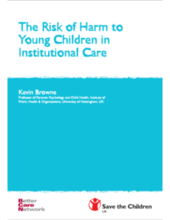Young children are frequently placed in institutional care throughout the world. This occurs despite wide recognition that institutional care is associated with negative consequences for children’s development (Carter, 2005; Johnson, Browne and Hamilton-Giachritsis, 2006). For example, young children in institutional care are more likely to suffer from poor health, physical underdevelopment and deterioration in brain growth, developmental delay and emotional attachment disorders. Consequently, these children have reduced intellectual, social and behavioural abilities compared with those growing up in a family home.
This paper provides an international summary of the extent and scale of young children living without parents in residential care ‘children’s homes’, and of the reasons they are there. This is followed by an overview of the risk of harm to young children’s care and development after being placed in institutional care, and considers core recommendations for policy and practice to prevent harm and promote the rights of a child to grow up in a family environment (UNCRC, 1989). To begin, a definition of what is meant by ‘institution or residential care home for children’ is presented to clarify the use of the term in this paper.
An institution or residential care home for children is defined as a group living arrangement for more than ten children, without parents or surrogate parents, in which care is provided by a much smaller number of paid adult carers. Typically in Europe this would be one carer to six children of a similar age during the day and fewer staff at night. Often the staff are inadequately trained and poorly supervised, making basic mistakes such as feeding a child (who should be able feed himself) on his back in a sleeping position (see plate 1).
Residential care implies an organised, routine and impersonal structure to the living arrangements for children (eg, all children sleep, eat and toilet at the same time) and a professional relationship, rather than parental relationship, between the adults and children. It is recognised that this definition would include children admitted to hospital, children in emergency care and those who attend boarding schools and summer camps. Therefore, children who live in an institution without a parent for more than three months are ‘institutionalised children’ and the focus of our concern.
Institutions or residential care homes for children are sometimes incorrectly referred to as ‘infant homes’ or ‘orphanages’. The so-called ‘infant homes’ often provide a non-stimulating, clinical environment for toddlers and young children up to four years of age, and the vast majority (94 to 98%) of children in ‘orphanages’ have at least one living parent, often known to the authorities (Browne et al., 2005, 2006; Carter, 2005; Tobis, 2000). It is acknowledged that these figures do not refer to children in conflict or disaster zones, but even in these areas only a minority of children in institutions are orphans, with many of them being displaced and separated from a living parent or relative whose whereabouts may be unknown. Perhaps the increasing numbers of HIV orphans in sub-Saharan Africa are the only exception to this misnomer, although it has been reported that 59% of children from Zimbabwe living in institutions have at least one parent alive, and there is much anecdotal evidence that the majority of ‘HIV orphans’ in sub-Saharan Africa, whether in institutional care or otherwise, have at least one living parent.
©Better Care Network and Save the Children UK

